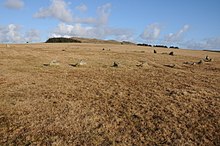Fernacre
 Fernacre stone circle | |
| Location | Bodmin Moor, Cornwall |
|---|---|
| Coordinates | 50°35′24″N 4°37′21″W / 50.58995°N 4.62237°W |
| Type | Stone circle |
| History | |
| Periods | Bronze Age |
Fernacre (grid reference SX14477997), also known as Fernacre stone circle or Fernacre circle, is a stone circle located on the slopes of the De Lank River, 1.25 miles (2.01 km) northeast of St Breward on Bodmin Moor in Cornwall in the United Kingdom.[1][2]
Description
It has been suggested to mean bracken-land or come from the old plural for
Archaeology
The ruins of what was called Fernacre farm were first recorded in 1327
AD.[7] Numerous hut circles dot the landscape nearby and it has been suggested that the dating for Fernacre is contemporary with these.[8] No bones or remains were found in these hut circles, only a few flaked flints gave clues to its occupation.[9] The Fernacre settlement covered 164 acres, of which 84 show signs of having been farmed.[2] The dating of the sites is uncertain although it has been suggested to have been constructed either in the Neolithic or Bronze Age.[10] There are signs that the circle had a retaining bank of earth on its southeast.[11]
Alignments
Fernacre carries a pivotal location between
Brown Willy Cairns, another small erect stone stands in this line eastwards on the way to Brown Willy which has been suggested to mark the equinox sunrise.[4][13] William Page note that when viewed from the centre of Fernacre circle the sunset on 1 May would align approximately with Louden Hill.[14]
Literature
- William Borlase (1754). Observations on the antiquities, historical and monumental, of the county of Cornwall ...: Consisting of several essays on the first inhabitants, Druid-superstition, customs, and remains of the most remote antiquity, in Britain, and the British Isles ... With a summary of the religious, civil, and military state of Cornwall before the Norman Conquest ... Printed by W. Jackson, in the High-Strand.
- William Copeland Borlase (1872). Naenia Cornubiae: the cromlechs and tumuli of Cornwall. Llanerch. ISBN 978-1-897853-36-8.
- William C. Lukis (1885). The prehistoric stone monuments of the British Isles: Cornwall. Printed for Nichols and Sons for the Society of Antiquaries.
- Aubrey Burl (2005). A guide to the stone circles of Britain, Ireland and Brittany. Yale University Press. ISBN 978-0-300-11406-5.
References
- ^ William C. Lukis (1885). The prehistoric stone monuments of the British Isles: Cornwall. Printed for Nichols and Sons for the Society of Antiquaries.
- ^ ISBN 978-91-22-01997-8.
- ^ Susan M. Pearce (1981). The archaeology of South West Britain. Collins. p. 212.
- ^ a b British Association for the Advancement of Science. Meeting; British Association for the Advancement of Science (1908). Report of the annual meeting. Office of the British Association. p. 371.
- ISBN 978-0-300-11406-5.
- ^ William Page (1906). Cornwall. Archibald Constable & Co. p. 394.
- ISBN 978-0-7134-1845-3.
- ^ Society of Antiquaries of London (1908). Archaeologia, or miscellaneous tracts relating to antiquity. The Society.
- ^ American journal of archaeology. 1910.
- ^ Prehistoric Society (London; England); University of Cambridge. University Museum of Archaeology and Ethnology (2005). Proceedings of the Prehistoric Society for ... University Museum of Archaeology and Ethnology. p. 357.
- ISBN 978-0-415-05845-2. Retrieved 23 March 2011.
- ISBN 978-1-4191-7324-0.
- ^ Thomas Rice Holmes (1971). Ancient Britain and the invasions of Julius Caesar. Books for Libraries Press. p. 211.
- ^ William Page. The Victoria history of the county of Cornwall. Constable. Retrieved 23 March 2011.
External links
Wikimedia Commons has media related to Fernacre stone circle.

